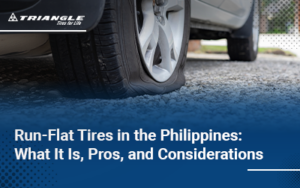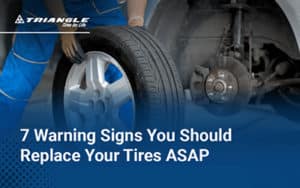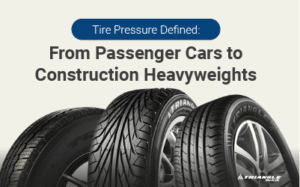When it comes to automotive well-being, there are plenty of things to consider. One of those crucial elements is the tire pressure monitoring system (TPMS). Although often overlooked, TPMS preserves your vehicle’s integrity and ensures a safe and smooth journey. Despite its significance, many drivers still ask, “How does TPMS work?”
In this infographic, you’ll discover TPMS functionality, types, and benefits. Whether you’re a seasoned driver or new to the world of automobiles, understanding TPMS can help you maintain your vehicle’s optimal performance and practice safer driving on the road.

What is a Tire Pressure Monitoring System (TPMS)?
A tire pressure monitoring system (TPMS) is a safety feature that monitors tire air pressure using sensors inside each tire. It alerts drivers via a gauge, pictogram, or warning light to ensure proper inflation, performance, and safety.
These sensors transmit real-time data to a central computer or dashboard display, giving instant alerts if any tire deviates from the recommended levels. By providing timely warnings, TPMS helps you take corrective action, such as inflating or adjusting tire pressure. As a result, you reduce the risk of accidents caused by under or overinflation.
One thing unique about a TPMS is its ability to enhance fuel efficiency and prolong tire lifespan. The device helps optimize fuel consumption through proper tire pressure maintenance, as underinflated tires lead to greater fuel consumption. Additionally, keeping the correct tire pressure reduces wear and tear, extending the longevity of tires and minimizing the need for premature replacements.
Direct TPMS vs. Indirect TPMS: Key Differences
There are two TPMS types: direct and indirect. While both systems serve the same purpose, you’ll find certain nuances for each. To know which TPMS is more suitable for your vehicle, below is a breakdown of their functionalities:
-
Direct TPMS
As the name suggests, direct TPMS utilizes individual pressure sensors installed inside each tire to measure air pressure. These sensors continuously monitor tire pressure and transmit real-time data to the vehicle’s onboard computer system.
One of the most distinguishing traits of direct TPMS is its high accuracy and reliability. Because it directly measures each wheel’s air pressure, it provides precise readings and allows for more effective monitoring of tire health. The immediate feedback alerts you promptly if there are any deviations from the recommended tire pressure levels so you can quickly address the issue.
Direct TPMS is particularly beneficial if your vehicle carries heavy loads or does towing, as it can accurately detect changes in tire pressure regardless of the vehicle’s configuration. This TPMS type is also most appropriate if your vehicle has performance-oriented tire setups or operates at high speeds, such as sports cars.
-
Indirect TPMS
In contrast, indirect TPMS doesn’t rely on individual tire pressure sensors. Instead, it tracks each wheel’s rotational speed—the speed at which a tire rotates around its axis as your vehicle moves forward.
An underinflated tire is smaller than a properly inflated one and would rotate more quickly than a larger one.
Although this system is less vulnerable to the sensitivity of direct sensors, it requires more care.
For one, an indirect system needs resetting whenever you add or adjust tire pressure. Failure to do so may lead the system to interpret the newly inflated tires as a potential hazard.
Meanwhile, the advantage of an indirect TPMS is its simplicity and cost-effectiveness. It doesn’t require the installation of individual sensors in each tire, making it less expensive to implement and maintain.
However, some consider indirect TPMS less accurate and reliable than its direct counterpart, relying on indirect measurements like wheel speed to gather data on tire pressure changes. Indirect TPMS may also not provide real-time feedback.
Overall, indirect TPMS is best if you value affordability and easy maintenance and is suitable for budget-friendly cars or fleet vehicles for minimal costs.
7 Benefits of TPMS
TPMS are technological innovations for vehicle safety and efficiency. These systems offer many advantages that go beyond tire maintenance. From enhancing fuel efficiency to reinforcing driving safety, TPMS can help deliver a smooth and safe journey on the road.
Below are several key benefits of installing a TPMS and how this innovative technology can make a difference in easy, efficient driving:
1. Enhanced fuel efficiency
Optimal tire pressure maintenance has a direct link to improved fuel efficiency. Under and overinflated tires increase rolling resistance, which puts a greater strain on the engine and burns more fuel. With TPMS providing real-time monitoring and alerts for tire pressure deviations, you can immediately resolve any trouble and have the correct tire pressure.
TPMS can also significantly contribute to cost savings by maximizing every drop of fuel; this is especially useful for long-distance driving or city commuting.
2. Extended tire lifespan
Proper tire inflation is essential for preserving tire integrity and extending lifespan, as underinflated tires can cause uneven tread wear on the sides and premature degradation. Conversely, overinflated tires can lead to irregular wear on the center portion of the tire tread. These issues can result in more frequent tire vulcanizing or replacements.
Fortunately, a TPMS helps maintain optimal tire pressure levels and control unnecessary wear and tear. These requirements are vital, especially when your vehicle carries varying loads or goes through harsh driving conditions, such as off-road adventures or commercial transportation.
3. Reduced environmental impact
TPMS reduces greenhouse gas emissions and environmental pollution by promoting proper maintenance and minimizing fuel consumption. With fewer fuel emissions released into the atmosphere, TPMS can mitigate air pollution and combat climate change.
Less environmental impact is especially crucial in densely populated urban areas or regions with strict emissions regulations, where every effort to reduce carbon footprint counts. Because of TMPS’ role in preventing tire wear and frequent replacements, you decrease your environmental footprint associated with tire production and disposal. Think of TMPS as an eco-friendly choice for modern drivers like you.
4. Helps reinforce driving safety
TPMS safety features alert you to potential tire issues before they escalate into road hazards. Whether detecting a slow leak, sudden pressure loss, or overinflation, TPMS can provide prompt alerts, allowing you to take corrective action and maintain control of your vehicles.
A TPMS can also help correct bad driving habits by notifying you of potential tire issues caused by poor practices like sudden acceleration, hard braking, or aggressive cornering. A swift response can deter or minimize the impact of accidents while ensuring your safety and fellow road users.
5. Optimized vehicle performance
From cornering at high speeds to navigating challenging terrain, TPMS can help maintain tire integrity and responsiveness. You can enjoy precise vehicle control and performance as the system maximizes traction, handling, and overall driving dynamics.
Additionally, TPMS technologies deliver consistent performance and stability by preventing underinflation-induced tire wear. This feature enhances leisure travel and daily commutes.
6. Time and cost savings
One major advantage of a TPMS is its ability to save time and money. Because it provides real-time tire pressure monitoring, you can fix potential issues before they escalate into costly and major repairs or replacements.
For example, detecting a slow leak early on allows you to address the problem promptly, preventing further damage to your tire. It also reduces the chances of changing a flat tire or a roadside breakdown, which helps lower the total operating costs associated with vehicle ownership. Thus, installing a TPMS is a wise investment for budget-friendly driving.
7. Road safety
When you have a TPMS that constantly monitors and maintains optimal tire pressure, it’ll be much easier to focus on the road and drive confidently. Whether embarking on a long road trip or going through your daily city drive, a TPMS provides reassurance that your tires will perform as intended, mitigating tire-related incidents.
Drive Smarter and Safer with a TPMS
A TPMS is vital for all drivers. Whether you choose direct or indirect, the system offers many benefits beyond simple tire maintenance. From enhancing fuel efficiency and extending tire lifespan to reducing environmental impact, there’s a lot a TPMS can do for your vehicle.
Quality tires that complement your TPMS are available from Triangle Tires. We have a diverse selection of affordable yet reliable tires for vehicles like passenger cars and light trucks. Browse our tire catalog or get in touch with us today to achieve peak performance and road safety.


